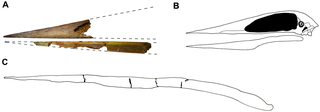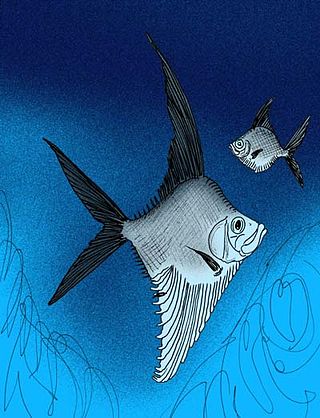
Pteranodon ; from Ancient Greek πτερόν and ἀνόδων is a genus of pterosaur that included some of the largest known flying reptiles, with P. longiceps having a wingspan of over 6 m (20 ft). They lived during the late Cretaceous geological period of North America in present-day Kansas, Nebraska, Wyoming, South Dakota and Alabama. More fossil specimens of Pteranodon have been found than any other pterosaur, with about 1,200 specimens known to science, many of them well preserved with nearly complete skulls and articulated skeletons. It was an important part of the animal community in the Western Interior Seaway.
Haasiophis, consisting of the sole species Haasiophis terrasanctus, is an extinct genus of snakes with hind limbs. It is one of three genera of Cenomanian snakes known to have possessed hindlimbs.
Pachyrhachis is an extinct genus of snake with well developed hind legs known from fossils discovered in Ein Yabrud, near Ramallah, in the central West Bank. It is a relatively small snake, measuring more than 1.5 metres (4.9 ft) long at maximum. Pachyrhachis appears to have been an ancient marine snake; the fossils occur in a marine limestone deposit, and the thickened bone of the ribs and vertebrae would have functioned as ballast to decrease the buoyancy of the animal, allowing it to dive beneath the ancient Cretaceous seas that it once inhabited.
Saurorhamphus is an extinct genus of prehistoric fish. Fossils are known from the Late Cretaceous (Cenomanian) of the former Tethyan region, but an undescribed specimen is also known from Mexico.

Mythunga is a genus of anhanguerid pterosaur from the late Early Cretaceous of Australia. Fossil remains of Mythunga dated back to the Albian stage of the Early Cretaceous, and the animal itself was found to be a close relative of another Australian anhanguerid called Ferrodraco.

The Kem Kem Group is a geological group in the Kem Kem region of eastern Morocco, whose strata date back to the Cenomanian stage of the Late Cretaceous. Its strata are subdivided into two geological formations, with the lower Ifezouane Formation and the upper Aoufous Formation, with the Gara Sbaa Formation and Douira Formation used in the southern Tafilalt region. It is exposed on an escarpment along the Algeria–Morocco border.
Haasiasaurus is an extinct genus of early mosasaur, originally named "Haasia" by M. J. Polcyn et al., in honour of the palaeontologist Georg Haas. Haasiasaurus was one of the oldest cenomanian mosasaur measuring 1 metre (3.3 ft) long. The genus contains the species Haasiasaurus gittelmani, which was found in the Cenomanian 100 million years ago rocks near Ein Yabrud, in the Palestinian West Bank, approximately 20 kilometres (12 mi) north of Jerusalem.

Uktenadactylus is a genus of anhanguerid pterodactyloid pterosaurs from the Lower Cretaceous Paw Paw Formation of Texas, United States and the Wessex Formation on the Isle of Wight, England. Fossil remains of Uktenadactylus dated back to the Early Cretaceous period, from about 125 to 100 million years ago.
Aetodactylus is a genus of targaryendraconian pterosaur. It is known from a lower jaw discovered in Upper Cretaceous rocks of northeastern Texas, United States.
The Tarrant Formation is a geologic formation that dates to the Middle Cenomanian stage of the Late Cretaceous.

Alanqa is a genus of pterodactyloid pterosaur from the Late Cretaceous period of what is now the Kem Kem Beds of southeastern Morocco. The name Alanqa comes from the Arabic word العنقاءal-‘Anqā’, for a mythical bird of Arabian culture.

Rhombichthys intoccabilis is an extinct clupeomorph described from the town of Ein Yabrud, in the West Bank. It lived during the Cenomanian age of the Late Cretaceous epoch.

During most of the Late Cretaceous the eastern half of North America formed Appalachia, an island land mass separated from Laramidia to the west by the Western Interior Seaway. This seaway had split North America into two massive landmasses due to a multitude of factors such as tectonism and sea-level fluctuations for nearly 40 million years. The seaway eventually expanded, divided across the Dakotas, and by the end of the Cretaceous, it retreated towards the Gulf of Mexico and the Hudson Bay. This left the island masses joined in the continent of North America as the Rocky Mountains rose. From the Cenomanian to the end of the Campanian ages of the Late Cretaceous, Appalachia was separated from the rest of North America. As the Western Interior Seaway retreated in the Maastrichtian, Laramidia and Appalachia eventually connected. Because of this, its fauna was isolated, and developed very differently from the tyrannosaur, ceratopsian, hadrosaurid, pachycephalosaur and ankylosaurid dominated fauna of the western part of North America, known as "Laramidia".

Boreopteridae is a group of pterodactyloid pterosaurs from the Aptian-age Lower Cretaceous Yixian Formation of Liaoning, China.
The Sannine Formation, also called the Sannine Limestone, is a Cretaceous geologic formation in Lebanon.
The Amminadav Formation is a Mesozoic geologic formation in the West Bank (Palestine). Pterosaur fossils have been recovered from the formation, in addition to several ray-finned fish and early snakes, most of which are known from the Ein Yabrud quarries. The formation overlies the just slightly older Bet-Meir Formation, and it is uncertain whether most of the paleobiota belong to one formation or the other.

Ferrodraco is an extinct genus of anhanguerid pterosaur known from the Late Cretaceous Winton Formation of Queensland, Australia, containing the single species F. lentoni. The species was named after the former mayor of Winton, Graham Thomas ‘Butch’ Lenton. It is the most complete pterosaur fossil from Australia, being known from the holotype specimen AODF 876, consisting primarily of the anterior portion of the skull and dentary, cervical vertebral centra and a partial wing. Its wingspan was estimated to be about 4 meters (13 ft). Ferrodraco was found to have been within the subfamily Ornithocheirinae, as sister taxon to Mythunga. A recent study also recovered Ferrodraco as sister taxon to Mythunga, but both placed within the family Anhangueridae, more specifically within the subfamily Tropeognathinae. Ferrodraco is also the latest surviving member of Anhangueria.

Leptostomia is a genus of long-beaked pterosaur from the mid-Cretaceous (?Albian-Cenomanian) of Morocco, North Africa. The type species is L. begaaensis, which was named and described in 2021 from sediments of the Kem Kem Group in Morocco. It was a small animal with a long, slender bill which is thought to have been used to probe sediments for worms and other invertebrates, similar to kiwi birds and curlews. Leptostomia is likely a member of the Azhdarchoidea.
Calcarichelys is an extinct genus of protostegid turtle from the Late Cretaceous of the Selma Formation in Alabama, and possibly from Angola. It contains only one species, C. gemma.

Scalacurvichthys is an extinct genus of pycnodontine pycnodontiform fish from the Amminadav Formation or Bet-Meir Formation in the West Bank; Palestine. The type species is S. naishi, only known from the holotype.












